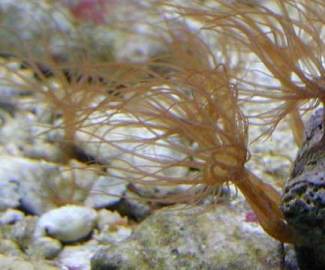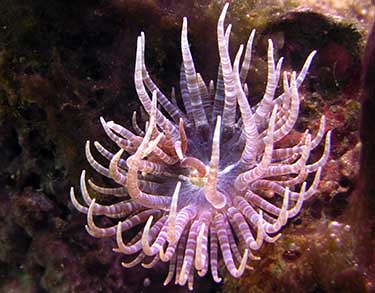Kill it with fire!!! Okay, scratch that, killing it with fire would not be the best option in this particular instance. You can kill it with Kalkawasser solution which is pricey, or buy things like Chem Marine, or Stop Aiptasia…but that isn’t fun either. It’s also expensive. Compared to other things you will buy for your tank it isn’t terribly expensive but it isn’t cheap either and if you’re like me you’d rather buy something like coral, or feeder fish, or Jeffery’s, or even…another eel! Not some pricey chemical that could possibly hurt your precious coral, feather dusters, or other interesting creatures – like those Hawaiian Lined Fireworm that patrol your rocks and substrate.
Today, I bring you the rarely referenced solution that will cost you a whole $.25. Gasp, shock, awe, 25 cents!? Impossible!
Au contraire! A medical syringe will cost you only $.25 and if you cook, or bake, or have a neighbor with a lemon tree that’s all you’re going to pay. Even if you don’t cook, or bake (geeze) you could be really thrifty and juice a lemon you get in a cup of iced tea, or just buy one at the store for about $.25 and you’re still paying less than a dollar to kill Aiptasia.
Getting a syringe is easy, if unlike us you don’t go out on a Saturday evening and find that because of the financial crisis everyone is closing their pharmacy before 6pm. However, once you make it to a pharmacy that is open and you dutifully read your little list off of exactly what you need (Latex free syringe for 30ml and the smallest needle possible .5mm) the look you will receive is priceless. Like those old Visa commercials, there really is nothing that compares to the head cocked to the side appearance of a pharmacy technician who eyeballs you like a junky and says, “Okay…so…what do we need a needle for?”
Then you get to explain to them what Aiptasia is, the scourge of the seven aquarium seas, a vile interloper bent on conquering your tank, and that the solution is a hypodermic syringe and a lemon. They will not laugh, they will wonder if you are crazy, everyone in line will believe you are the weirdest junkie ever, but they will get you a syringe. Best part of it is, I didn’t even have to pay taxes on my syringe, and it was a single shiny quarter. The pharmacy tech even wished me good luck on the way out, with that still questioning tone of voice. I’m willing to bet if she hasn’t already, she’ll Google this within the week and I hope she finds this blog. Thank you pharmacy tech lady, should you ever read this.
So to recap what we have learned so far:
- Aiptasia is pretty, but evil.
- Syringes are very inexpensive and easy to come by, but there is a bit of explaining to be had when trying to purchase one.
- Lemons grow on trees, are found in your iced tea, and are really cheap as well.
 Aiptasia is an anemone that spreads very quickly if you hurt it. Never rip it out of the rocks with tweezers, stab it with a barbeque skewer, or otherwise make tiny Aiptasia particles. Each one of those could turn into another Aiptasia. Furthermore if you rip it out of the rocks with tweezers or eviscerate it with a skewer (which is cathartic but ineffective) you probably haven’t destroyed the disc and it will grow back along with all the little babies you helped it produce. Think of it like a mushroom coral, really, really hard to kill, really easy to frag.
Aiptasia is an anemone that spreads very quickly if you hurt it. Never rip it out of the rocks with tweezers, stab it with a barbeque skewer, or otherwise make tiny Aiptasia particles. Each one of those could turn into another Aiptasia. Furthermore if you rip it out of the rocks with tweezers or eviscerate it with a skewer (which is cathartic but ineffective) you probably haven’t destroyed the disc and it will grow back along with all the little babies you helped it produce. Think of it like a mushroom coral, really, really hard to kill, really easy to frag.- Destroying Aiptasia with any of the methods listed in 1 is very fun, but very bad for your tank.
- Aiptasia can trick you by looking very similar to a baby polyp, so look at pictures before you start killing it or you may regret it. Once you know what it looks like however, it’s easy to tell the difference between the two.
- Aiptasia is quick, and it will hide from you faster than you can remember Speedy Gonzales ever running. Be aware of this, plan accordingly. At times the Aiptasia will not poke back out of the live rock for several minutes, and it can even take a day. It’s a jerk, that’s why we hate it, don’t freak out.
Pulling a piece of live rock out of the tank and boiling it is a great last resort, but it’s going to make your house stink and it will kill absolutely everything in the rock. Peppermint shrimp are often mislabeled and unless you get the exact species it’s not going to eat the anemone and in most cases it will still ignore it. Ditto with the fish and our hermit-Jeffery were of no help even though they supposedly eat Aiptasia. Also, if you have predatory/aggressive fish they probably eat the creatures that eat the anemone. Then you’re just buying a really expensive snack.
Lemon juice on the other hand will only cause a slight Ph increase, won’t hurt anything else in the tank, and it’s cheap – I mentioned that it’s cheap right?
So, you’ve got your needle, your lemon, and your Aiptasia…now what?
- Assemble the needle if it isn’t already affixed to the syringe.
- Juice your lemon and try to make sure there isn’t any pulp, or if you’re using lemon juice skip this step.
- Insert the needle into the lemon juice and pull back until the syringe is full.
- Spurt out air in the most theatrical way possible but shield your eyes. Lemon juice stings, really.
- Turn off your powerheads, wave maker, et cetera – leave your skimmer on and your return pump – it shouldn’t cause any problem if you leave everything on but it’s better to be safe.
- Look directly at the Aiptasia because that bugger may hide the second you stick your arm in the tank, they’re sneaky. If you know where you should be looking because you have it in your head that makes it easier to wait for it to pop out because these anemones can be difficult to see from every angle, speaking of which make sure you are at a good angle to keep your eye on the Aiptasia before you stick your arm in the tank.
- Go slow as you move your hand holding the syringe through the water so as not to spook your worthy victim and then insert the needle into the base of the Aiptasia. Inject it with 5-10ml of fluid depending on its size. You have to do this quickly because the critter is going to freak out. The Aiptasia will dart back into itself and seal the lemon juice inside of it, helping to poison itself, which is just icing on the cake.
- Within 3 days (for us it was 1) the Aiptasia will shrivel into white ghostly nothingness, never to return.
Now…wasn‘t that the best $.25 you ever spent?

As long as you leave my beautiful Jefferies alone, you can take a stab at the Aiptasia.
ReplyDeleteHow is the newest fishy Pancho Francios?